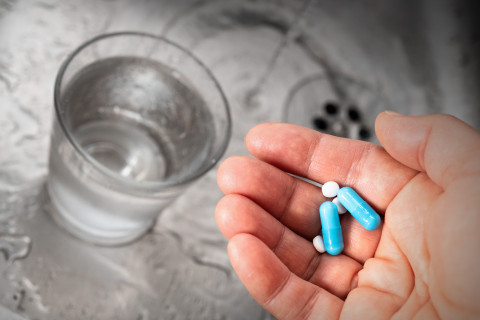Did you know that the medicines you use may end up polluting the environment? Finns are concerned about the environmental effects of medicines – and rightfully so.
In a survey carried out last autumn, 70 per cent of the respondents said that they were concerned about the effects that medicines may have on the environment. An even higher percentage of the respondents were of the opinion that there is not enough information available on the subject. “Having a more eco-friendly pharmaceutical policy starts with increasing awareness. Perhaps in the future, the environmental impact of pharmaceuticals will be compared in the same way as the carbon footprint of products,” says Early-stage Researcher Lasse Alajärvi at the University of Eastern Finland School of Pharmacy.
The multidisciplinary research project SUDDEN (short for Sustainable Drug Discovery and Development with End-of-Life Yield) funded by the Strategic Research Council aims at reducing the environmental hazards related to the life cycle of pharmaceuticals. Alajärvi’s role in the project is to study the views of consumers as well as pharmaceutical and healthcare professionals on a pharmaceutical policy that promotes environmentally friendly decision-making.
Fimea charts the Finnish people’s opinions on medicines with its Medicines Barometer survey, which is carried out every second year. The latest Medicines Barometer also had questions about the environmental effects of medicines. Researchers have recently analysed the results of the survey for an upcoming research article.

Medicine users are the largest source of pharmaceutical pollution
With the aging of the population and the ever-increasing use of medical products, the amount of pharmaceutical residue that reaches the environment is also growing. Pharmaceuticals intended for human consumption primarily end up in the environment when used appropriately for their usual purposes. Pharmaceuticals are released to wastewater every time we use the toilet or take a shower. A small amount of pharmaceutical pollution is attributable to the incorrect disposal of medicines and, at least in Europe, only a few percent of the emissions are generated by the pharmaceutical industry.
“The survey shows that the consumers’ perception of the sources of emissions are quite the opposite. Consumers think that most of the emissions related to the life cycle of a pharmaceutical are generated by the pharmaceutical industry, while their own medicine use has little or no effect on the chemical burden that pharmaceuticals cause on the environment. In reality, medicine users at home and in hospitals or long-term care facilities are the main source of pharmaceutical pollution.”
Aren’t pharmaceuticals removed from wastewater at the wastewater treatment plant? “Surprisingly few pharmaceuticals are actually efficiently removed at the wastewater treatment plant – many of them even end up discharged in the water system untreated. Traditional wastewater treatment technology is not designed to efficiently remove concentrations of pharmaceuticals at the molecular level.”
“Medicines are designed to have an effect on the human body even in low concentrations, they are required to have a long shelf life, and active pharmaceutical ingredients potentially continue to have effects when released into the environment. The metabolites of pharmaceuticals may also have environment impacts, but research data is still limited. Human and veterinary medicines are both sources of pharmaceutical pollution,” says Alajärvi.
Around 30–90 percent of medications taken orally are estimated to enter the environment as active pharmaceutical ingredients with the potential of producing biological effects on plants or animals.
A painkiller killed the vultures – fish received hormone therapy by accident
An eyeopening example of the environmental effects of pharmaceuticals is when vultures became close to extinction in the Indian subcontinent in the 1990s. The anti-inflammatory drug diclofenac used on cattle proved to be toxic to vultures, who consumed it via dead cows. Finns know diclofenac from its use in topical gel nonsteroidal anti-inflammatory drugs, for example.
Residues of painkillers, anti-microbials, anti-depressants and contraceptives have been detected in water bodies and soil in Europe. Released to the environment, anti-microbial agents may help bacteria become resistant to antibiotics. Exposure to anti-depressants and hormone replacement medication, on the other hand, has been observed to affect the behaviour and reproductive functions of fish. Moving up the food chain, humans may also be exposed to drug residue found in nature via food and drinking water.

New pharmaceutical innovations are currently required to go through environmental risk assessment, however, even if risks are detected, it does not prevent getting authorisation to sell the pharmaceutical product. “The most important thing is still to ensure that the disease gets treated and that the medication is safe for the user. In the future, consumers will also be able to compare medical products based on the level of environmental risk they cause when an environmental classification system for pharmaceuticals will be introduced in Finland.
Alajärvi says that the implementation of the environmental classification of pharmaceuticals has not been confirmed yet, but it could present a competitive edge comparable to carbon neutrality for pharmaceutical companies. The minimisation of environmental risks should be incorporated into the pharmaceutical development process from its very beginning.
The SUDDEN project also examines solutions for increasing the effectiveness of the recycling of pharmaceutical packing materials and the removal of drug residue from wastewater. The recycling of blister packs is especially problematic as they are currently disposed of in mixed waste due to being comprised of plastic and aluminium that cannot be sorted separately.
Based on the survey, instead of disposing unused medicines in the sewer or mixed waste, which causes chemical burden on the environment, people in Finland often bring their unused medicines to the pharmacy, where they are disposed of accordingly. “Finns are model citizens in this regard,” says Alajärvi.
Alajärvi points out that protecting the environment is not sufficient reason for not taking medication when it is needed, however, choosing a smaller pack helps avoid generating medical waste. “The unnecessary use of pharmaceuticals should be avoided of course. There are also many non-pharmaceutical alternatives recommended for pain, for example. Life style choices can also eliminate the need to take medication.
Read more about the SUDDEN project: https://sudden.fi/en/



